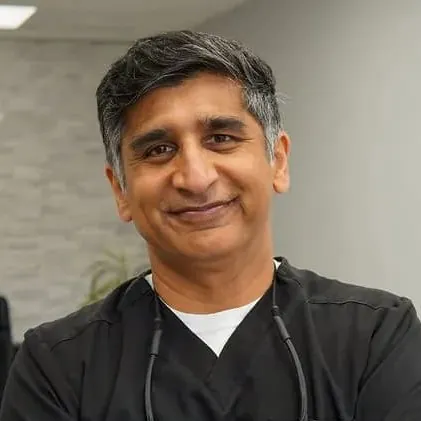Start here if you want to dig deeper on specific services:
- Dental Implants in Chicago, IL
- Implant-Supported Overdentures
- Same-Day Teeth in Chicago
- Tooth Extractions
Tooth Replacement Options — Quick Comparison
| Dental Implants | Implant-Supported Overdentures | Fixed Bridge (Traditional, no implant) | Partial Denture (Flipper/Metal Partial) | Complete Denture | |
|---|---|---|---|---|---|
| Best for | one tooth or several | full arch (top or bottom) | a single missing tooth when an implant isn’t chosen | several missing teeth | full arch when implants aren’t used |
| Chewing stability | high (fixed) | medium–high (implants add strong retention) | medium (fixed) | low–medium (removable) | medium (removable; may need adhesive) |
| Bone preservation | yes | partial | no | no | no |
| Care | brush/floss like natural teeth; routine cleanings | remove/clean daily; periodic maintenance | special floss under the pontic; regular hygiene | remove/clean; adjustments as the mouth changes | remove/clean; relines over time |
| Typical timeline | weeks–months depending on healing and whether grafting is needed | weeks–months | several weeks | several weeks | several weeks |
When Each Option Makes the Most Sense
Missing just one tooth
A single dental implant replaces the root and crown without touching the neighboring teeth, so function feels natural and bone stays stimulated. A traditional fixed bridge is fast and can look great, but it requires reshaping the adjacent teeth and doesn’t prevent bone loss under the gap. A flipper can hold the space short-term while you plan definitive care.
Missing several teeth in a row
You can restore with multiple implants or an implant-supported bridge (fewer implants supporting several teeth). A partial denture is a budget-friendly removable option, though it’s less stable for chewing.
Missing all upper or lower teeth
Two proven paths: implant-supported overdentures (removable but locked into implants for far better hold) or fixed full-arch solutions like Same-Day Teeth. Both boost confidence and chewing power; fixed options feel closest to natural teeth.

What to Expect at 3020 Dental: Option Details
At 3020 Dental Implants, your comfort and satisfaction are our top priority, which is why we offer a wide range of missing teeth replacement options designed to meet your unique needs, oral health, and the number of missing teeth.
Dental Implants
Dental implants are tiny metal posts our dentist inserts into your jawbone beneath your gums. They support a custom-designed dental prosthetic, whether a single crown or a full denture.
Implants provide a secure structure by being inserted into the jawbone, ensuring your restorations won't move or slide when you eat or talk. Because of that, having a healthy and sufficient amount of jawbone is crucial to being a good candidate for implant dentistry.
If that’s not the case, you may need a sinus lift or bone graft surgery before being able to receive dental implants.
Implant-Supported Bridge
Similar to conventional bridges, this dental restoration method uses a dental implant to anchor the bridge directly into the jawbone. This provides a secure base for replacement teeth without affecting your remaining natural teeth.
Implant-Supported Overdenture
Rather than simply resting on the gums, like conventional dentures, implant-supported overdentures are supported by dental implants. The overdenture can snap or clip onto the stable foundation created by these implants, which are inserted into the jawbone.
Compared to conventional dentures, an overdenture is more comfortable and secure. It minimizes movement and enhances the wearer's capacity for speech and eating. It provides a more stable and long-lasting option for those missing some or all of their teeth.
Why replace a missing tooth sooner rather than later?
- Keep teeth aligned: neighbors drift into open space and can throw off your bite.
- Preserve bone: roots (or implants acting like roots) stimulate the jaw; without that, bone shrinks.
- Chew and speak with ease: stability matters, especially for varied, nutritious foods.
- Protect remaining teeth: stable forces reduce wear and fractures elsewhere.
FAQs
What’s the “best” option to replace missing teeth?
It depends on how many teeth you’re replacing, your bone health, and your goals. For one tooth, an implant often wins on function and bone preservation. For a full arch, implant-retained or fixed full-arch options offer far more stability than conventional dentures.
How much do dental implants cost in Chicago?
Costs vary by case, diagnostics, grafting needs, the number of implants, and the type of restoration. We’ll review transparent ranges and financing during your consultation so you can choose what fits your plan and budget.
How long does treatment take?
Some candidates can leave with provisional teeth the same day. When grafting or staged healing is needed, expect several months. We’ll map your exact timeline after imaging.
Do I need bone grafting before implants?
Sometimes. If the jawbone is thin or soft, a graft or sinus lift helps create the foundation for strong, long-lasting implants. 3D imaging tells us for sure.
Ready to compare your options with a team that does this every day?
Request an implant consultation and we’ll build a plan around your health, your timeline, and your budget.



